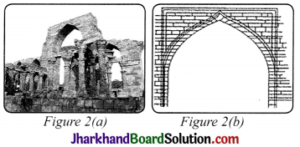JAC Board Class 7 Social Science Notes Geography Chapter 3 Our Changing Earth
→ The lithosphere is fragmented into a number of plates known as the Lithospheric plates.
- Lithospheric plates move around very slowly say just a few millimetres each year, this happens because of the movement of the molten magma inside the earth.
- The earth movements are classified on the basis of the forces which cause them.
- Two types of forces works: The forces which act in the interior of the earth are known as Endogenic forces and the forces that work on the surface of the earth are known as Exogenic forces.
- Sudden movements such as earthquakes and volcanoes cause mass destruction over the surface of the earth.
- A vent means opening in the earth’s crust through which molten material erupts suddenly is known as a volcano.
- When the Lithospheric plates move, the surface of the earth vibrates which travel all round the earth. These vibrations are known as earthquakes. The focus is the place in the crust where the movement starts. The epicentre is the place on the surface above the focus.
- Though earthquakes cannot be predicted, but some common earthquake prediction methods adopted locally by the people include studying animal behaviour such as fish in the ponds get agitated, snakes come to the surface, etc.
- The device used for measuring earthquake is Seismograph. Richter scale helps to measure the magnitude of the earthquake.
![]()
→ Earthquake preparedness – where to take shelter when earthquake occurs.
- Safe spots are under a kitchen counter, a table, against an insided comer or wall.
- Stay away from fire places such as chimneys, windows with glass pane, pictures.
- Always be prepared by spreading awareness among your family members and friends and face any disaster and hurdle confidently.
→ Major Land Forms:
- The landscape is being continuously worn away by two processes, they are weathering and erosion.
- The breaking up of the rocks on the earth’s surface is known as Weathering. The wearing away of the landscape by different agents like water, wind and ice is known as Erosion.
- The process of erosion and deposition create different and numerous landforms on the surface of the earth.
→ Work of a River:
- A waterfall is formed when the river tumbles at steep angle over very hard rocks or down a steep valley side.
- Meanders are formed by turns and large bends when the river enters the plain and twists.
- An ox-bow lake is formed in due course of time when the meander loop cuts off from the river and forms a cut-off lake.
- As the river floods, it deposits layers of fine soil and other material called sediments along its banks and this leads to the formation of a flat fertile flood plain. Thus, the raised banks are called levees.
- The speed of the flowing river decreases as it approaches the sea and river begins to break up into a number of streams known as distributaries.
- A delta is formed by the collection of sediments from all the mouths.
→ Work of Sea Waves:
- Sea caves are the hollow caves which are formed on the rocks.
- Sea arches are formed when these cavities become bigger and bigger in size and only the roof of the caves remain.
- Stacks are the only walls which are left where erosion breaks the roof. Sea cliff are the steep rocky coast rising almost vertically above sea water.
- The sea waves deposit sediments along the shores forms the beaches.
→ Work of Ice:
- Rivers of ice which too erode the landscape by bulldozing soil and stones to expose the solid rock below is known as Glaciers.
- The different material carried by the glacier such as rocks big and small, sand and silt gets deposited and these deposits form glacial moraines.
![]()
→ Work of Wind:
- Mushroom rocks are the rocks which you find in deserts in the shape of a mushroom.
- When the wind stops blowing the sand falls and gets deposited in low hill like structures are known as sand dunes.
- The grains of sand becomes very fine and light, the wind can carry it over very long distances. When such sand is deposited in large areas, it is known loess. Large deposits of loess is found in China.
